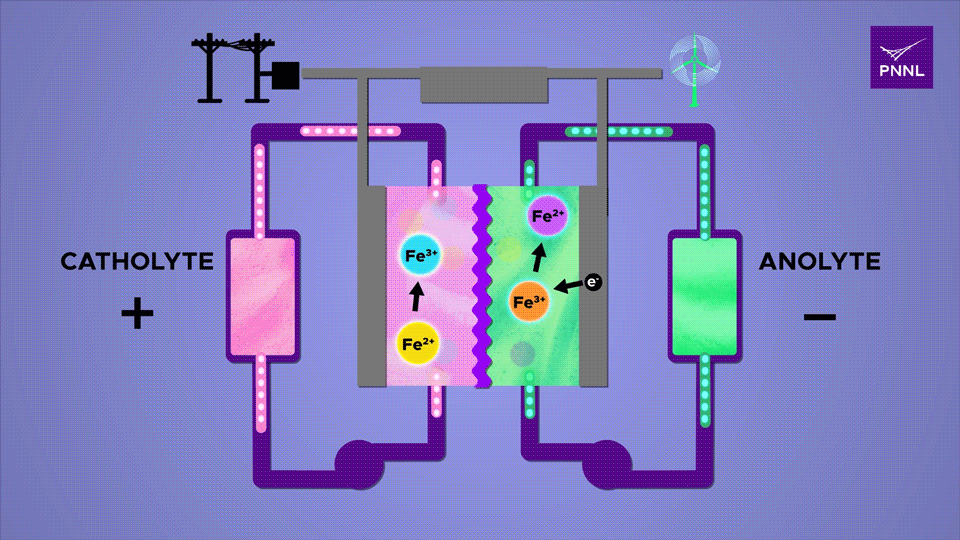Researchers at the Department of Energy’s Pacific Northwest National Laboratory (PNNL) have created a new battery design using a commonplace chemical found in water treatment facilities. Founded in 1965, PNNL aims to address challenges in sustainable energy and national security. Their new design will cater to the growing demand for renewable energy sources like wind and solar power in the nation’s electric grid.
Scientists reveal new flow battery tech based on common chemical
At the center of the design is a lab-scale, iron-based flow battery with unparalleled cycling stability.

A representational image of high voltage electric power lines at sunset.
At the center of the design is a lab-scale, iron-based flow battery with unparalleled cycling stability. According to a statement, the battery “exhibited remarkable cycling stability over one thousand consecutive charging cycles, while maintaining 98.7 percent of its maximum capacity. ” This is quite a significant improvement compared to previous options which were vulnerable to considerable degradation.
Another defining factor for this battery is its utilization of a unique liquid chemical formula that charges iron with a neutral-pH phosphate-based liquid electrolyte. This compound, nitrogenous triphosphate, nitrilotri-methylphosphonic acid (NTMPA), is commercially available due to its use in water treatment plants to inhibit corrosion.
Senior author Guosheng Li, a senior scientist at PNNL and senior author of the study, said, “We were looking for an electrolyte that could bind and store charged iron in a liquid complex at room temperature and mild operating conditions with neutral pH. We are motivated to develop battery materials that are Earth-abundant and can be sourced domestically.”

Using Flow batteries for city-wide installation
The flow batteries used by the researchers are characterized by their two-chamber design and continuous circulation of electrolyte liquids. They also offer a versatile solution for energy storage. According to the statement, the batteries charge through an electrochemical reaction and store energy in chemical bonds. This energy can then be used to power electrical devices.
Unlike conventional batteries, these can be deployed at any scale, from lab settings to city-wide installations, and can even serve as backup generators for the electric grid.
The aqueous iron redox flow battery developed by PNNL researchers represents a promising advancement in this domain. It shows the potential for grid-scale deployment with enhanced safety features.
Aaron Hollas, a study author and team leader at PNNL, highlighted the safety benefits of the aqueous flow battery system, particularly its operation at neutral pH in water. “A BESS facility using the chemistry similar to what we have developed here would have the advantage of operating in water at neutral pH,” Hollas remarked. “In addition, our system uses commercially available reagents that we have not previously investigated for use in flow batteries.”
RECOMMENDED ARTICLES
Despite its current energy density of 9 watt-hours per liter (Wh/L), lower than commercialized vanadium-based systems, the PNNL-designed battery holds promise for future improvements. Guosheng Li, senior scientist at PNNL, outlined plans to enhance battery performance, focusing on aspects such as voltage output and electrolyte concentration to increase energy density.
Looking ahead, the researchers envision scaling up the technology at the Grid Storage Launchpad. “Our next step is to improve battery performance by focusing on aspects such as voltage output and electrolyte concentration. This will help to increase the energy density,” Li added. “Our voltage output is lower than the typical vanadium flow battery output. We are working on ways to improve that.”
The study was published in the journal Nature Communications.
The Blueprint Daily
Stay up-to-date on engineering, tech, space, and science news with The Blueprint.
By clicking sign up, you confirm that you accept this site's Terms of Use and Privacy Policy
ABOUT THE EDITOR
Abdul-Rahman Oladimeji Bello Abdul-Rahman is a seasoned SEO writer and journalist with over seven years of experience spanning different writing spheres. His proficiency reaches beyond words as he holds a Banking & Finance degree, Graduate Certificates in International Business Management and Supply Chain Management, and a Diploma in Accounting and Business. Yet, he understands that science and engineering are essential to keep the wheel of innovation running. His vast knowledge encompasses tech, finance, environmental issues, science, engineering, and politics. An enthusiastic coffee lover, he relishes the bold taste of a quality brew every morning, starting his day on a vibrant note.




0